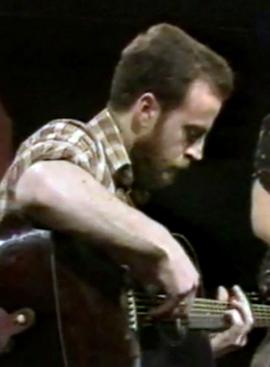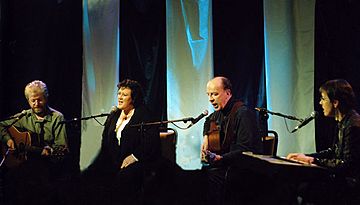Mícheál Ó Domhnaill facts for kids
Quick facts for kids
Mícheál Ó Domhnaill
|
|
|---|---|

Mícheál Ó Domhnaill, 1979
|
|
| Background information | |
| Birth name | Mícheál Seosamh Ó Domhnaill |
| Born | 7 October 1951 Kells, County Meath, Ireland |
| Died | 7 July 2006 (aged 54) Dundrum, Dublin, Ireland |
| Genres | Irish traditional, Celtic, folk |
| Occupation(s) | Musician, composer, producer |
| Instruments | Guitar, vocals, banjo, mandolin, piano, organ, tin whistle, harmonium, harmonica |
| Years active | 1971–2006 |
Mícheál Ó Domhnaill (born October 7, 1951 – died July 7, 2006) was an amazing Irish musician. He was a singer, guitarist, composer, and producer. Mícheál had a huge impact on Irish traditional music in the late 1900s. People remember him for his new ideas with bands like Skara Brae and The Bothy Band. Skara Brae was the first group to record songs in the Irish language with harmonies. The Bothy Band became one of the most important groups in Irish traditional music history. Mícheál also worked with the fiddler Kevin Burke. Later, he joined Celtic groups like Relativity and Nightnoise, which became very popular.
Mícheál grew up in Kells, County Meath, Ireland. He spent his summers in Rann na Feirste, a part of Donegal where people speak Irish. He learned to love Irish culture and music from his parents. His aunt Neilí, a famous singer, taught him many Irish and English songs. He also became lifelong friends with Pól and Ciarán Brennan (who later formed Clannad) and Dáithí Sproule.
Contents
Mícheál's Early Life
Mícheál Seosamh Ó Domhnaill was born on October 7, 1951, in Kells, Ireland. His father, Aodh, was a teacher and a singer. He also collected traditional music. Mícheál's mother, Bríd, sang in a choir. His father grew up in Rann na Feirste, where Irish is the main language. Mícheál, his two sisters, Maighréad and Tríona, and two brothers, Éamon and Conall, all loved Irish culture.
The family spent their summers in Rann na Feirste. There, they learned the Irish language and traditional music. Mícheál and his siblings spent time with their aunt Neilí. She was a well-known singer with many Irish and English songs. They also became close friends with Pól and Ciarán Brennan and Dáithí Sproule.
Mícheál started piano lessons at age six. When he was twelve, he had an appendicitis. To help him feel better, a teacher gave him a guitar. By age sixteen, Mícheál focused most of his musical energy on the guitar. He and his sisters sang Irish songs together, creating beautiful harmonies. Their father told them to "listen across one another" to find the perfect blend. Tríona later said, "We could just look at each other in the midst of a song, and that look would communicate so much. When you've close family ties, it's instinctive."
Skara Brae: A New Sound
In the late 1960s, Mícheál and Tríona went to University College Dublin. There, they met Dáithi Sproule, a singer and guitarist. They started playing Irish Gaelic songs together in Dublin. Their music was "beautiful and adventurous." In 1970, Mícheál and Dáithi played as the house band in Donegal. Later that year, Mícheál, Tríona, Maighread, and Dáithi formed the group Skara Brae. Mícheál named the band after an ancient village in Scotland.
In 1971, Skara Brae released their first album. It was special because it was the first time Irish language songs were recorded with vocal harmonies. Mícheál explained in an interview that they learned a lot from The Beatles. They tried to bring that new sound to Irish music. Skara Brae's songs showed the unique style of their home area, Rann na Feirste. Mícheál and Dáithí were among the first guitarists in Irish traditional music to use a special guitar tuning called DADGAD. Their guitar style greatly influenced other musicians.
While studying in Dublin, Mícheál met Mick Hanly, another singer and guitarist. They formed a duo called Monroe. They played Irish, English, and Scottish songs. Their music featured acoustic guitars, a dulcimer, and their voices. Monroe often toured in Brittany, France, where folk music was very popular.
After finishing college in 1973, Mícheál worked for the Irish Folklore Commission. He collected songs in Donegal. He met many musicians and spent hours with his aunt Neilí. He learned over 200 traditional songs from her. Many songs he later recorded were ones he first learned from Neilí.
In 1974, Mícheál became the first host of an RTÉ radio show called The Long Note. It featured Irish traditional musicians, many of whom had never been recorded before. Hanly and Ó Domhnaill also recorded a song called "The Hills of Greenmore." They toured with the famous group Planxty. With help from Planxty members, they recorded the album Celtic Folkweave. This album was later called a "seminal" album and a "predecessor to The Bothy Band".
The Bothy Band: A Powerful Group
In late 1974, Mícheál helped start the very popular group The Bothy Band. The band included Matt Molloy (flute), Paddy Keenan (uilleann pipes), Dónal Lunny (bouzouki, guitar), Paddy Glackin (fiddle), and his sister Tríona Ní Dhomhnaill (harpsichord, vocals). Paddy Glackin was later replaced by Tommy Peoples, and then by Kevin Burke. In just five years, The Bothy Band became one of the most exciting groups in Irish traditional music. Their music came from traditional Irish tunes, and their energy set a high standard for other performers.
The Bothy Band played their first show on February 2, 1975. They only recorded three studio albums: The Bothy Band (1975), Old Hag You Have Killed Me (1976), and Out of the Wind – Into the Sun (1977). A live album, After Hours, came out in 1979. Their first album quickly made them famous. Their second album, Old Hag You Have Killed Me, made them even more popular. Their final studio album cemented their place in Irish traditional music.
In 1979, the group broke up. However, the members continued to be important in Irish traditional music. Dónal Lunny joined other bands and became a producer. Tríona Ní Dhomhnaill moved to the United States. She later joined her brother to form Relativity and Nightnoise.
Kevin Burke and Moving to America
After The Bothy Band ended, Mícheál and fiddler Kevin Burke formed a duo. They recorded the album Promenade (1979). This album is considered "one of the finest duets ever recorded in Irish traditional music." Their music was calm and beautiful, different from the powerful sound of The Bothy Band. One reviewer called their sound "soulful finesse."
The main song on the album was "Lord Franklin", which featured Mícheál's lovely singing in English. He also sang two other songs in Irish. Mícheál's guitar playing and Burke's Sligo-style fiddling created a "relaxed vitality."
In 1980, Mícheál and Burke moved to the United States. They toured all over the country. In 1982, they released their second album, Portland. Critics loved it just as much. Reviewers praised Mícheál's "tender, baring passion" in songs like "Eirigh a Shiuir." His guitar playing was quiet but strong, always supporting Burke's fiddle playing.
While touring in Portland, Oregon in 1980, Mícheál met Peg Johnson. They fell in love and got married two years later. Mícheál lived in Portland for the next fourteen years.
Nightnoise: A New Musical Journey
In 1983, Mícheál wanted to try something new. He met Billy Oskay, an American violinist, in Portland. They started working together to create a new kind of music. It mixed traditional Irish, jazz, and classical music. They recorded songs at Oskay's home and liked what they heard.
In late 1983, William Ackerman from Windham Hill Records heard their music. He loved it and offered Mícheál and Oskay a contract. The songs they recorded were released in 1984 on their album Nightnoise. This album was very different from Mícheál's earlier work. It had a calm, instrumental style that blended jazz and classical elements. This sound helped define what became known as New Age music.
In 1985, Mícheál and his sister Tríona joined two Scottish brothers, Phil Cunningham and Johnny Cunningham. They formed the group Relativity. They released two successful albums: Relativity (1985) and Gathering Pace (1987).
In 1987, Tríona and Irish-American flutist Brian Dunning joined Mícheál and Oskay to form the band Nightnoise. Their first album, Something of Time, came out in 1987. They followed it with At the End of the Evening (1988) and The Parting Tide (1990). These albums were very popular and helped the group tour the United States, Japan, and Europe. Their music combined "original acoustic chamber music with an Irish feel." It mixed jazz, classical, folk, and new age styles.
Nightnoise allowed Mícheál to explore new musical ideas and reach more listeners. He still kept the spirit of Irish traditional music in his new creations. He said that even when they wrote music with different structures, it still sounded Celtic because he was Irish.
After Billy Oskay left Nightnoise in 1990, Johnny Cunningham joined the band. The band's sound became more focused on Irish music, but still kept its unique style. This new Nightnoise released Shadow of Time (1994), A Different Shore (1995), and The White Horse Sessions (1997). The White Horse Sessions was their last album. Johnny Cunningham left, and John Fitzpatrick replaced him. Nightnoise officially broke up in late 1997.
Later Years and Legacy
In 1997, Mícheál moved back to Ireland. He lived in Dundrum, Dublin. In the late 1990s, he and other former Nightnoise members performed on a TV show called Brid Live. In 2001, he teamed up with his old friend Paddy Glackin, the original Bothy Band fiddle player. They toured and recorded the album Athchuairt. Glackin praised Mícheál for making Irish language songs popular with more people. He said Mícheál "re-fashioned them and made them accessible to a new generation."
Mícheál Ó Domhnaill passed away on July 7, 2006, from a heart attack at his home. He was 54 years old. Many musicians from Ireland attended his funeral. Ireland's Minister for Arts, John O'Donoghue, said, "Mícheál Ó Domhnaill was one of Ireland's most gifted and well loved musicians. His contribution to the world of traditional and folk music was enormous. His passing is a great loss and he will be sadly missed." Mícheál was buried in St. Colmcille's Cemetery in Kells, County Meath.
On May 24, 2007, many Irish musicians gathered in Dublin to celebrate Mícheál's life and music. Performers included Paddy Keenan, Dónal Lunny, Kevin Burke, Mary Black, Maighread Ní Dhomhnaill, and Tríona Ní Dhomhnaill.
Mícheál's Musical Gear
Mícheál used different guitars throughout his career. Early on, he played a Guild dreadnought guitar. In 1977, he had a special guitar made for him by Kenny White. In the 1990s, he played a 1975 Martin D-28 guitar. He said it "wasn't a great instrument when I bought it, but it was a Martin, and I knew it would improve if I played it." He also owned a custom-made guitar by Terry Demezas. Mícheál preferred medium-gauge strings and used a large triangular pick when not fingerpicking. He also played tin whistles and a pedal harmonium.
Mícheál's Music Albums
|
With Skara Brae
With Mick Hanly
With The Bothy Band
With Kevin Burke
With Billy Oskay
With Relativity
With Nightnoise
With Paddy Glackin
Other Albums He Played On
|
Compilation Albums (Collections of Songs)
|


